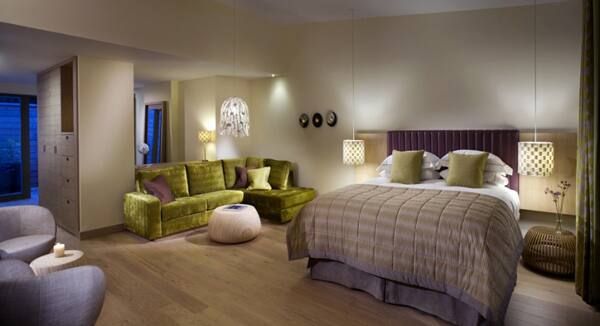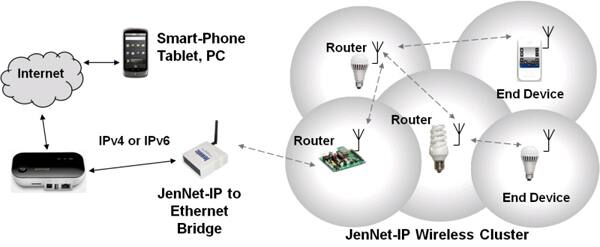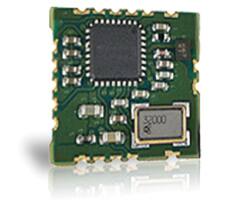Internet-Enabled LEDs Allow Smartphone Control of Intelligent Lighting Systems
投稿人:DigiKey 欧洲编辑
2013-01-02
Many of us were somewhat skeptical of the ‘internet of things’ concept when it was first bandied about some years ago. Who on earth wants a fridge or toaster that connects to the internet? What’s the point of having every LED lamp in the building accessible online? The answers, or rather the applications, are now a lot more obvious. Whether people are attracted by ‘smart’ technology, watching their carbon footprint, or simply trying to save money by using less energy, home automation is the up-and-coming application.
The skeptics will say that home automation has been an up-and-coming application for decades now. This is true, but there are significant differences today that are heralding real change. First, ‘connected’ technology has become ubiquitous, with barely a cost penalty, even for devices as small and low cost as LED lamps or sensors.
Second, wireless network standards are finally stabilizing. There is choice, depending on application, which provides healthy competition, and there is widespread (and still growing) industry support. Underlying this point is the recent introduction of IPv6, which provides the addressing capacity that makes it possible to give a unique IP address to any and every device on the planet.
Third, consumers are becoming much more attuned to controlling their lives and their environment through the internet, particularly if it can be done through their smartphones.

Figure 1: Residential lighting is a prime target for control via a smartphone, once integrated as part of an internet-enabled wireless network. Photo source: Philips Lighting Controls.
Of course, home automation involves many aspects, including lighting, heating, entertainment, security and energy management, ultimately interconnected via a home area network (HAN). This article will focus on lighting control, and in particular, intelligent systems that are internet-enabled, and therefore accessible via gateways, using a smartphone as a control device.
Bringing more sophisticated control to smart lighting systems is useful for several reasons: energy and cost savings, security, comfort, convenience and lifestyle benefits are the obvious appeal in the residential sector. For commercial buildings and both indoor and outdoor civic applications, the focus on lighting control is primarily to deliver increased energy and cost savings and improved security, largely, but not necessarily entirely, driven by government legislation and pressure from international environmental campaigns.
Meanwhile, advanced LED technology has brought additional functionality, such as adaptive lighting control, involving dimming, balancing, and accurate color mixing, as well as automated lighting scenarios and scheduling systems. All these advanced features require sophisticated programmable control. Furthermore, the ability to access and control lighting schemes remotely opens up new vistas for maintenance and trouble-shooting, perhaps less critical for the home, but important in managed residential, public and commercial buildings and especially in outdoor installations. In these latter applications, although the smartphone is rarely going to be the primary control mechanism, it has become important that the networked control systems support access via such devices. Consider the role of roaming security personnel or a field service technician, for example.
Gaining control
The first stage towards intelligent lighting schemes is the integration of microcontrollers with the LED and driver. Microcontrollers are the obvious choice for exploiting the latest intelligent features, and especially remote connectivity. Ultra-low-power microcontrollers are readily available for this type of application. Optimized devices can be found with sufficient performance and the right mix of peripherals and communications ports to potentially control all three major components of a lighting system: the power stages, LED lighting control, and communications. Size-wise, the digital control circuitry is now small enough to embed in a single lamp for individual control, as well as by clusters or zones.
Furthermore, microcontroller-based systems can be reconfigured through the code to support modifications, new functionality, or expansion of the lighting scheme. More information on microcontrollers for LED lighting control is available through Reference 1. The incorporation of digital control opens the way to smarter, more flexible, and connected technologies and applications.
As a result of the advances in easily affordable, digitally-controllable LEDs and drivers, interest in IPv6-enabled smart lighting systems has soared. A fast-growing ecosystem of innovative vendors is gaining visibility through supplying lighting, connectivity, and energy management solutions, often as part of a more complete home automation or infrastructure application.
In terms of wireless networking, vendors envision that the smart home will exploit a mixed network topology, including high-bandwidth nodes using Wi-Fi, alongside low power standards such as ZigBee and Z-wave, as well as ultra-low-power 6LoWPAN-compatible protocols. Suppliers keen to penetrate the home automation sector are committed to promoting affordability and interoperability, making it more easily accessible for consumers, and thereby growing the market.
A year ago, Google did much to stimulate interest in home automation with a public demonstration of controlling intelligent lighting systems, via an Android phone, during its annual Android developer’s conference. Unfortunately, Google’s application does not appear to have been commercialized. Neither is the company’s Android@Home initiative for home automation yet visible, although it has not yet been written-off by its supporters.
Practical solutions
Meanwhile, practical solutions are now beginning to emerge from a wide range of companies, many of which are working together in partnerships, and typically involved in either or both the LED lighting and wireless networking sectors. In addition, there are a growing number of home automation specialists.
One of the most promising solutions currently on the market is the combination of NXP Semiconductors’ GreenChip LED driver technology and its ultra-low-power JenNet-IP network layer software (See Figure 2).

Figure 2: Schematic of how a smartphone can control a lighting system via internet connectivity and a wireless network.
Starting from the bottom up, LED controllability begins with the driver. NXP’s vast portfolio of LED lighting controller ICs has expanded over the past two years to include new models under the GreenChip (high efficiency) banner. The family includes devices for both commercial and residential applications, featuring a high level of integration and high efficiency in a compact size and a variety of form factors. Solutions are available for isolated and non-isolated topologies, suitable for flyback, buck, and resonant configurations, and in dimmable and non-dimmable versions.
The NXP GreenChip range of devices, which can also be exploited by manufacturers of compact fluorescent (CFL) lighting products, focuses on high efficiency (up to 95%) and low system cost. Depending on the application, designers can select variants in the range, with built-in or external MOSFET and power switch, for example, and for systems up to 10 W, 15 W or 25 W outputs.
Well proven in the NXP GreenChip range is the SSL21081 LED driver IC, for 100 to 120 V markets, and includes a 300 V internal switching MOSFET. It operates in a buck or buck/boost mode, and dimming is possible using direct pulse width modulation. Additional models cover higher voltage ranges. The SSL2103 LED driver, meanwhile, is a typical version available for dimmable lighting systems.
One of the latest products in the GreenChip SSL range is the SSL2109 LED lighting controller IC. It is a controller-only version of the SSL2108 family, and described as a high-efficiency buck controller for high power, LED lighting applications using non-isolated topologies. Designed for use with an external power switch, the device provides a single design platform for 10 V, 120 V and 230 V mains input voltages and power ranges up to 25 W. It provides manufacturers of LED retrofit (non-dimmable) lamps and driver modules with the flexibility to optimize external MOSFET selection, based on cost, performance, and heat dissipation, across different power levels. The device enables highly compact designs with only around fifteen components needed in a small PCB area.
The next stage of solid-state lighting control is via the microcontroller. A wide range of devices is available directly from a number of manufacturers, some of which are specifically targeted at operating with LED drivers for lighting control applications. Considerable coverage of this aspect can be found elsewhere (See Reference 1). It is useful to give one example here to illustrate the systems solutions approach being taken by some vendors. NXP, for instance, has developed ultra-low power 32-bit ARM Cortex-M0 based microcontrollers, including the LPC1112 and LPC1200. The LPC1112 is a very low cost, high-performance device for 8-/16-bit applications, achieved through dramatic reductions in code size. The later LPC1200 is targeted specifically at home automation applications, and offers greater design flexibility with a range of flash memory sizes, for example.
Wireless IP connectivity
Although NXP is by no means unique in offering smart, high performance, low-cost LED drivers and microcontrollers, few of its rivals have gone to the next stage of coupling their devices with wireless IP connectivity via an RF networking solution, fully compliant with industry standards. JenNet-IP is NXP’s enhanced 6LoWPAN network layer, specifically targeting ultra-low power networking, based on IEEE802.15.4, and operating in the 2.4 GHz ISM band. It is also secure, featuring the 128-bit AES encryption that comes with IEEE802.15.4 compliance.
Being IP-based, it is capable of scaling to support large networks of up to 500 devices, with or without internet gateways. Now an Open Source product, it is supported by a growing ecosystem of vendors, including lamp and gateway manufacturers and energy management solutions providers. A major benefit of JenNet-IP is that it enables interoperability with other communication standards in the home.
At the heart of the JenNet-IP networking software is the JN5148, ultra-low power, high-performance microcontroller combined with and IEEE802.15.4 compliant transceiver. It features an enhanced 32-bit risc processor, high coding efficiency, low power operation with programmable clock speeds and various sleep modes. The large memory footprint allows the device to run both the networking stack, such as ZigBee PRO, as well as the self-healing JenNet tree networking stack, plus an embedded application. It is therefore eminently suitable for the mixed network topology structures expected to be favored for home automation applications.
NXP has just announced an evaluation board, the JenNet-IP-EK040. The software development kit includes a complete tool chain for application development and debug, and is based on industry standard GNU tools running on Windows, with support under the Eclipse IDE. The evaluation kit runs a lighting demonstration for switching and dimming LED lamps using a remote control device, via a web interface, or via a Smartphone.
Meanwhile, another option for exploring this technology, not only for lighting control, but other home automation applications, is the EK010 evaluation kit based on the JN5148 microcontroller, with ZigBee PRO support. The microcontroller has been certified as a ZigBee compliant platform.
Cost driven
Technology-wise, when combined with an appropriate networking solution, the resulting compact, low-cost platform gives designers the flexibility to create tailored, intelligent lighting control schemes that help manage energy consumption, while improving functionality and comfort for the user. The overruling factor for awakening the potentially vast home automation market, however, is low cost. According to Gartner market research director, Mark Hung, “A wireless technology that can achieve a significant breakthrough in system cost has the opportunity to drive mass adoption of home automation by mainstream consumers.”
Systems companies are just starting to exploit this new wave of low-cost technology for the home automation market. Danish innovator GreenWave Reality has developed a connected intelligent lighting solution for smart home applications, based on NXP’s GreenChip and JenNet-IP technologies. It runs on the iPhone, iPad and Android devices, as well as through a dedicated remote control panel. It can be operated as a stand-alone lighting control system or as part of the company’s broader home energy management suite of products. At the heart of the solution is a concurrent radio gateway that supports multiple network standards including ZigBee and Z-Wave as well as the 6LoWPAN that NXP uses, and creates the access to the mesh-based home area network.
Making Z-waves
The Z-Wave wireless protocol is beginning to emerge as a strong contender for home automation systems, including lighting control. Based on the 868.42 MHz ISM frequency band, Z-Wave was originally developed in Denmark, but was acquired by US-based semiconductor manufacturer, Sigma Designs. The Z-Wave Alliance and its member companies now maintain and develop the upper layers of the standard, and have established final product certification requirements. The basic PHY/MAC layers have become a certified international standard.
With stability and the promise of longevity, the standard appeals to systems designers, not only for new and existing installations, but because it is designed to remain backward compatible. This allows not only equipment from different manufacturers to be operated in the same network, but also allows new products and functionality to be integrated easily without wholesale upgrades. In operation, the protocol offers frequency modulation features to minimize the problems of interference, and static source routing to minimize the communication overhead.
Z-Wave is said to deliver reliable wireless networking at a fraction of the cost of similar technologies by focusing on narrow bandwidth applications. The Z-Wave protocol stack is embedded in single chip solutions from companies including Sigma Designs. Its ZM4102 module, for example, delivers wireless mesh network technology to automatically route RF signals from one node to the next, around obstacles and radio dead spots. The ability to use Z-Wave protocol over IP networks allows easy, seamless connection to other networks and to the internet, thereby enabling control from devices such as smartphones.

Figure 3: Sigma Designs’ ZM4102 module uses Z-Wave to deliver wireless mesh network technology for home automation systems.
More than 100 integrators and systems designers worldwide are now members of the Z-Wave alliance, and dozens are citing lighting control as one of their key target applications. The standard has recently been accepted in Brazil and Japan, without the need for radio station licensing, even further expanding its scope.
Mesh networks
Staying with the ISM frequency band, Semtech, a US-based semiconductor manufacturer offering both lighting and wireless networking products, has teamed up with Virtual Extension to provide a two-chip wireless mesh network chipset. Claimed to be designed to bring a new level of performance and signal robustness to smart lighting applications, the SX1211 RF transceiver, operating over the 860 to 960 MHz frequency band, is paired up with the VE209S wireless mesh network controller. The transceiver is optimized for asynchronous sensor network designs, and all RF communication parameters can be reconfigured dynamically. Receiver current consumption is less than 3 mA, enabling long battery life. Evaluation kits are also available. The SX1211 starter kit provides the boards, modules, antennas and batteries necessary to evaluate the potential of Semtech’s lowest power RF transceiver.
The mesh controller device forms the heart of a VEmesh unit, which can be either a gateway to other networks, or a node. For indoor and street light control, the VEmesh network has the capability to support limitless numbers of nodes on a single network.
Systems integrators will be interested to know that Virtual Extension has recently partnered with Hadassim to provide a pre-integrated communications infrastructure for smart lighting, smart metering, and other remote monitoring and control applications. With access to Hadassim’s DCS cloud computing platform, integrators benefit from an easy-to-implement, fully-secure web access communications link. Software and tools are available for controlling and managing systems with central and remote control devices, as required.
Cloud cover
Following the cloud computing thread, another wireless technology and service supplier, Synapse Wireless, is targeting the lighting control sector with its SNAP internet-enabled network operating system, associated hardware, and software, and its own lighting cloud service.
Synapse’s SNAP network operating system is a portable, interoperable, multi-vendor solution for embedding intelligent, wireless communication into devices. The technology can be deployed in almost any application that requires internet-enabled, remote monitoring and control of machines, sensors, processes, and of course, lighting systems. The control and sensor devices are cable-free and energy efficient, and can be easily installed in new or existing buildings to yield energy savings from solid-state lighting. Once installed, lighting fixtures can be controlled, reconfigured or zoned in real time, from any web browser or smartphone.
The company offers a range of carefully designed, antenna-matched RF modules. Designers can select the model best for their application, such as the lowest cost, SM300 chip module, or the best for indoor, RF300PC1 RF module.
Conclusion and summary
This article has signaled the rapid growth currently taking place in the management and control of sophisticated lighting schemes, not only as part of the burgeoning home automation market, but also in commercial building and civic indoor and outdoor lighting applications. In particular, it focuses on the ability to control lighting schemes via a mobile phone.
Key technologies involved range from sophisticated LED drivers; ultra-low power and dedicated microcontrollers; low power, large node count wireless network protocols; through to mesh network controllers with internet connectivity. Although there are a huge number of players providing solutions in this field, this article has highlighted just a few in each category. Starting with NXP Semiconductors with its GreenChip LED controller and JenNet-IP wireless network technologies, Sigma Designs and its Z-Wave networking protocol, and Semtech and Synapse Wireless with their secure mesh network control devices and systems. Products include chips, modules, software and finished subsystems, as well as a range of evaluation and development kits for building intelligent lighting control systems.
References:
- DigiKey TechZone articles on microcontrollers for lighting control: Microcontrollers in Commercial Lighting Applications and Digital Lighting Controllers Drive a New Era in Industrial Illumination

免责声明:各个作者和/或论坛参与者在本网站发表的观点、看法和意见不代表 DigiKey 的观点、看法和意见,也不代表 DigiKey 官方政策。






 中国
中国